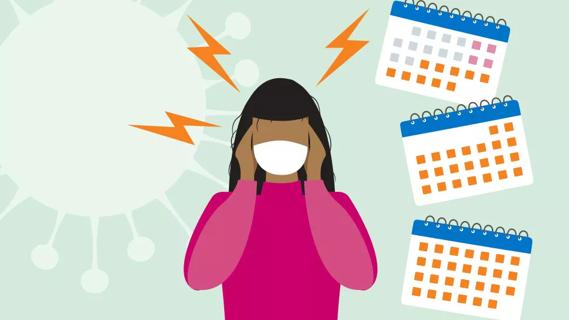Growing evidence links the virus to the neurological condition

With coronavirus (COVID-19) cases again increasing at an alarming rate, a symptom of the virus is gaining new notice with more prevalence: delirium.
Cleveland Clinic is a non-profit academic medical center. Advertising on our site helps support our mission. We do not endorse non-Cleveland Clinic products or services. Policy
There’s still so much we don’t know about the coronavirus, but the developments surrounding the delirium symptoms have both doctors and researchers concerned, especially as to how it may affect younger patients.
There’s growing evidence linking delirium and coronavirus patients. One study reports that between 20% and 30% of hospitalized coronavirus patients develop delirium while another study indicates as many as 70% of critically ill coronavirus patients are affected.
We spoke with neurocritical care specialist Pravin George, DO, about delirium in coronavirus patients and why it might be happening.
According to Dr. George, delirium is getting more notice as a symptom now but it’s likely it’s been a symptom of the virus all along. It likely went unnoticed in early cases, partly because some coronavirus patients have been under the influence of sedatives. And another reason has to do with the type of delirium.
There are two types of delirium:
And it’s possible for a patient to have a mix of the two.
According to Dr. George, the sedatives given to patients might have masked the presence of hypoactive delirium in some patients. But symptoms of hyperactive delirium like hallucinations are gaining more notice now.
While delirium isn’t currently listed as a COVID-19 symptom by the Centers for Disease Control (CDC), “new confusion” is now included as a potential “emergency warning sign” of the presence of COVID-19.
According to Dr. George, one cause of delirium in COVID-19 patients could be a lack of oxygen because of how the virus attacks the lungs.
Another cause could be the body’s reaction to the virus. “Inflammation caused by the way the body’s immune system overreacts to the virus could block blood to a patient’s brain,” says Dr. George.
Yet one more might be the virus actually attacking the brain. “The virus may be attacking neurons within the brain tissue. The brain has neurons that contain ACE2 receptors that are very similar to receptors found in the lungs that have served as gateways for the coronavirus to attack cells there,” says Dr. George.
It’s becoming clear that the coronavirus can attack more than just the respiratory system. And more studies are linking the virus with damage to the body’s central nervous system and other neurological issues, including delirium.
“When we first encountered the virus, the focus was on how it attacked the respiratory system,” says Dr. George. “A lot of the time it’s going through that respiratory system but what’s happening is that after it attacks the respiratory system, it starts to go into the brain, go into the kidneys, it goes throughout the body.”
As more has been learned about the virus, so, too, has the CDC expanded the list of symptoms to include issues caused by infections that reflect the wide-ranging effects it can cause: loss of taste or smell, diarrhea and headaches.
Another way the virus affects the body, says Dr. George, is by making the blood very thick which can lead to strokes. One study from the UK found that 57 out of 125 patients experienced an ischaemic stroke while 39 presented symptoms of “an altered mental state.”
And strokes caused by coronavirus infections have been detected in younger patients, causing alarm given that the latest surge of positive coronavirus cases have been driven by patients under the age of 40.
“This doesn’t necessarily mean that younger patients will experience these symptoms,” says Dr. George, “but it still has to be taken seriously, especially since younger patients represent a larger portion of new cases.”
“There’s still so much we don’t know about the virus,” he continues, “and these are serious, debilitating conditions that can have long-lasting health effects even if someone ‘recovers’ from the virus.”
Learn more about our editorial process.

COVID-19 may be associated with tinnitus, but research is still ongoing

The short answer: It’s complicated, but the basic care precautions still prevail, like washing your hands and isolating if you’re sick

They can feel like a typical headache or a migraine headache, but the pain can last for weeks to months

Any large social gathering — from a family birthday party to an indoor music concert — has the potential to spread serious infection

It’s important to connect with a healthcare provider, get quality sleep and balance your activities with your energy levels

Symptoms can overlap and be hard to distinguish, but there are some telltale differences

Just like the flu, COVID-19 will continue to evolve every year

It’s best to treat flu-like symptoms as if you have COVID-19

Your metabolism may torch 1,300 to 2,000 calories daily with no activity

A gentle touch in all the right places may help drain your sinuses